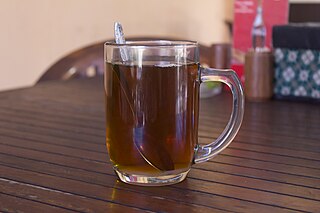
A drink or beverage is a liquid intended for human consumption. In addition to their basic function of satisfying thirst, drinks play important roles in human culture. Common types of drinks include plain drinking water, milk, juice, smoothies and soft drinks. Traditionally warm beverages include coffee, tea, and hot chocolate. Caffeinated drinks that contain the stimulant caffeine have a long history.

Yogurt is a food produced by bacterial fermentation of milk. Fermentation of sugars in the milk by these bacteria produces lactic acid, which acts on milk protein to give yogurt its texture and characteristic tart flavor. Cow's milk is most commonly used to make yogurt. Milk from water buffalo, goats, ewes, mares, camels, and yaks is also used to produce yogurt. The milk used may be homogenized or not. It may be pasteurized or raw. Each type of milk produces substantially different results.
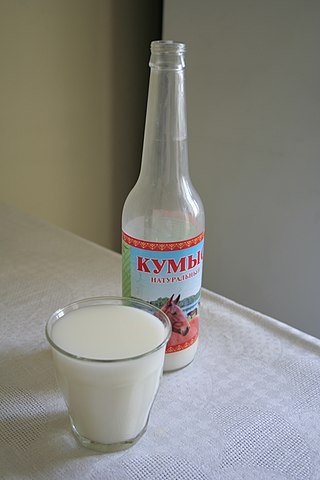
Kumis is a fermented dairy product traditionally made from mare milk or donkey milk. The drink is important to the peoples of the Central Asian steppes, of Turkic and Mongol origin: Kazakhs, Bashkirs, Kalmyks, Kyrgyz, Mongols, and Yakuts. Kumis was historically consumed by the Khitans, Jurchens, Hungarians, and Han Chinese of North China as well.

Calpis, sold in North America as Calpico, is a Japanese non-carbonated soft drink manufactured by Calpis Co., Ltd., a subsidiary of Asahi Breweries headquartered in Shibuya, Tokyo. The beverage has a light, somewhat milky, and slightly acidic flavour, similar to plain or vanilla-flavoured yogurt or Yakult. Its ingredients include water, dry milk, and lactic acid, and it is produced by lactic acid fermentation.

Makgeolli, sometimes anglicized to makkoli, is a Korean alcoholic drink. It is a milky, off-white, and lightly sparkling rice wine that has a slight viscosity, and tastes slightly sweet, tangy, bitter, and astringent. Chalky sediment gives it a cloudy appearance. As a low proof drink of six to nine percent alcohol by volume, it is often considered a "communal beverage" rather than hard liquor.

Arrack is a distilled alcoholic drink typically produced in Sri Lanka and Southeast Asia, made from the fermented sap of coconut flowers or sugarcane, and also with grain or fruit depending upon the country of origin. It is sometimes spelled arak, or simply referred to as 'rack or 'rak. It is not to be confused with the anise-flavored distilled spirit called arak or araq. In many parts of India arrack is colloquially known as "desi daru".

Iraqi cuisine is a Middle Eastern cuisine that has its origins in the ancient Near East culture of the fertile crescent. Tablets found in ancient ruins in Iraq show recipes prepared in the temples during religious festivals—the first cookbooks in the world. Ancient Mesopotamia was home to a sophisticated and highly advanced civilization, in all fields of knowledge, including the culinary arts.
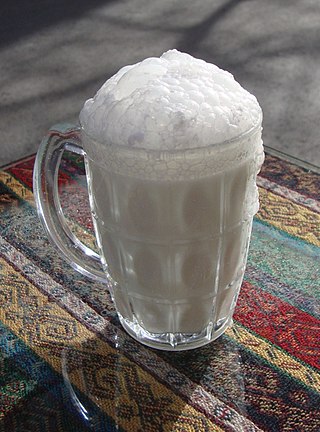
Ayran,dhallë, dew, Jaree'a, leben, avamast, çiqilmast, mastaw, shaneena, or xynogala is a cold savory yogurt-based beverage popular across Central Asia, West Asia, Southeastern Europe, South Asia, North Asia and Eastern Europe. The principal ingredients are yogurt, water and salt. Herbs such as mint may be optionally added. Some varieties are carbonated.

Kashk, qurut, chortan, or aaruul and khuruud is a range of dairy products popular in Iranian cuisine, Caucasian cuisine, and Central Asian cuisine. Kashk is made from strained yogurt, drained buttermilk or drained sour milk by shaping it and letting it dry. It can be made in a variety of forms, like rolled into balls, sliced into strips, and formed into chunks.
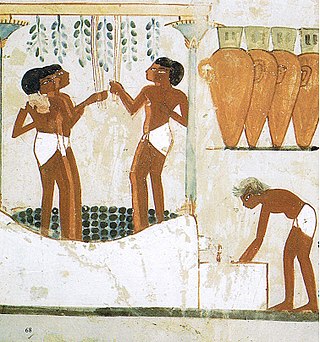
In food processing, fermentation is the conversion of carbohydrates to alcohol or organic acids using microorganisms—yeasts or bacteria—under anaerobic (oxygen-free) conditions. Fermentation usually implies that the action of microorganisms is desired. The science of fermentation is known as zymology or zymurgy.

Sizdah Bedar, also known as Nature's Day, is an Iranian festival held annually on the thirteenth day of Farvardin, the first month of the Iranian calendar (and the first month of spring, during which people spend time picnicking outdoors. It marks the end of the Nowruz holidays in Iran.
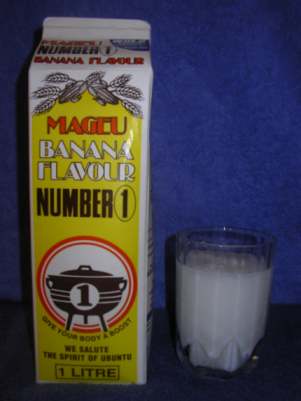
Mageu, Mahewu, Mahleu, Magau (xau-Namibia), Madleke, Mabundu, maHewu, amaRhewu or amaHewu is a traditional Southern African non-alcoholic drink among many of the Chewa/Nyanja, Shona, Ndebele, Nama Khoikhoi and Damara people, Sotho people, Tswana people and Nguni people made from fermented mealie pap. Home production is still widely practised, but the drink is also available at many supermarkets, being produced at factories. Its taste is derived predominantly from the lactic acid that is produced during fermentation, but commercial mageu is often flavoured and sweetened, much in the way commercially-available yogurt is. Similar beverages are also made in other parts of Africa.

Kefir is a fermented milk drink similar to a thin yogurt or ayran that is made from kefir grains, a specific type of mesophilic symbiotic culture. It is prepared by inoculating the milk of cows, goats, or sheep with kefir grains.

The term Leben, variously laban, liben, lben in the Middle East and North Africa, refers to a food or beverage of fermented milk. Generally, there are two main products known as leben: The yogurt variant for the Levant region and the buttermilk variant for parts of Arabia and North Africa (Maghreb). Leben can be served at breakfast, lunch, or dinner.

Sharbat is a drink prepared from fruit or flower petals. It is a sweet cordial, and usually served chilled. It can be served in concentrated form and eaten with a spoon or diluted with water to create the drink.

Sour cream is a dairy product obtained by fermenting regular cream with certain kinds of lactic acid bacteria. The bacterial culture, which is introduced either deliberately or naturally, sours and thickens the cream. Its name comes from the production of lactic acid by bacterial fermentation, which is called souring. Crème fraîche is one type of sour cream with a high fat content and less sour taste.
Carbonated milk or soda milk is a carbonated soft drink. It can be made from powdered milk or fresh milk, and often has added flavor. In addition to modified mouthfeel, carbonated milk also has a longer shelf-life than similarly processed flat milk and a different flavor. It is sold by several companies and is most popular in Asia.

Dahi or curd, also mosaru, dahi, thayir and perugu, is a traditional yogurt or fermented milk product originating from and popular throughout the Indian subcontinent. It is usually prepared from cows' milk, and sometimes buffalo milk or goat milk. The word curd is used in Indian English to refer to homemade yogurt, while the term yogurt refers to the pasteurized commercial variety known as "heat-treated fermented milk".















